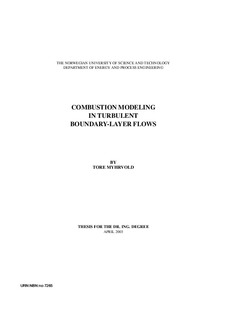| dc.description.abstract | This thesis presents an investigation of turbulence modeling and chemical-kinetics effects, including local extinction, for turbulent reacting boundary-layer flows by using Favre-averaged Navier-Stokes equations.
Local extinction effects with detailed chemistry calculations were investigated using the Eddy Dissipation Concept (EDC) by Magnussen for turbulent combustion. In this case, turbulent jet flames were used for validation, since it appears that there is no data for the detailed chemistry of turbulent reacting boundary-layer flows near walls. The predictions of a lifted jet flame by EDC were in reasonable accordance with measured data. Both k-ε-and Reynolds-stress-equation (RSE) turbulence models that were developed for constant and variable density were employed. These turbulence models predicted different residence times in the EDC reactor model, and therefore, local extinction was predicted differently.
Turbulence modeling was investigated by employing a full low-Reynolds-number RSE model, which was validated against DNS data for turbulent boundary-layer flow. The model was in reasonable agreement with the data, but more work is needed on certain parts of it, since better agreement for some of the terms was expected.
The behavior of EDC close to walls was discussed and a low-Reynolds-number version of EDC was proposed. When employing the proposed modification of EDC, and using a single-step (laminar) expression for the reactor reaction rate, it was shown that the mean chemical reaction term approaches the laminar expression at the wall.
The modeling of chemical reactions for a low-Reynolds-number turbulent premixed flame in a Couette flow (including a wall flame) with EDC was presented and the results were compared to DNS data. Finite-rate chemistry was used with a single-step mechanism. Both the standard version, and the proposed modification of EDC were tested and discussed. The predictions show that by introducing limits to the EDC mass fraction variable of finestructures regions, or by using the proposed low-Reynolds-number version, EDC predicted a reasonable flame picture compared to the DNS flame. These predictions indicate that the proposed low-Reynolds-number version of EDC could be a useful way to extend the model to turbulent reacting flows near walls. | nb_NO |
